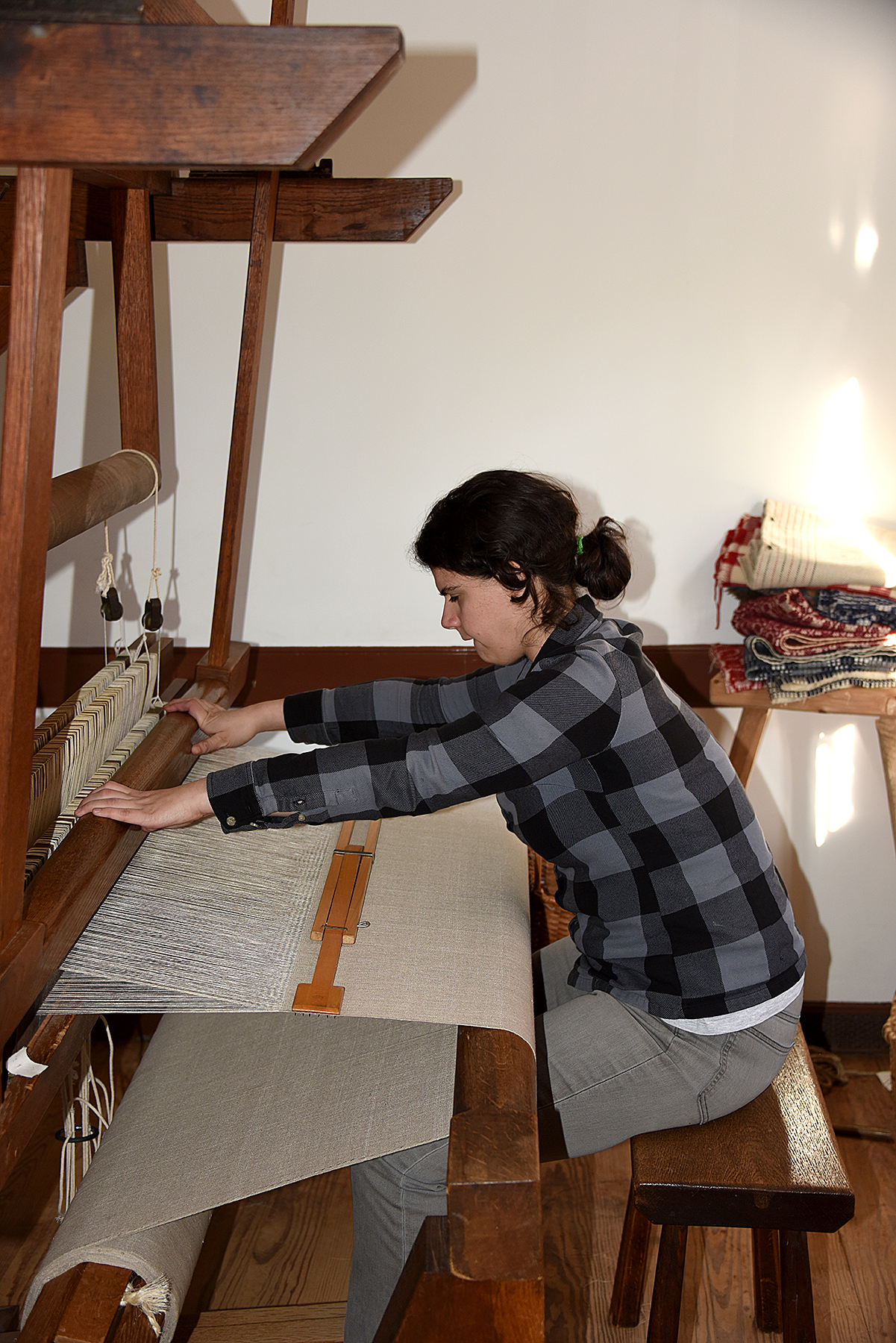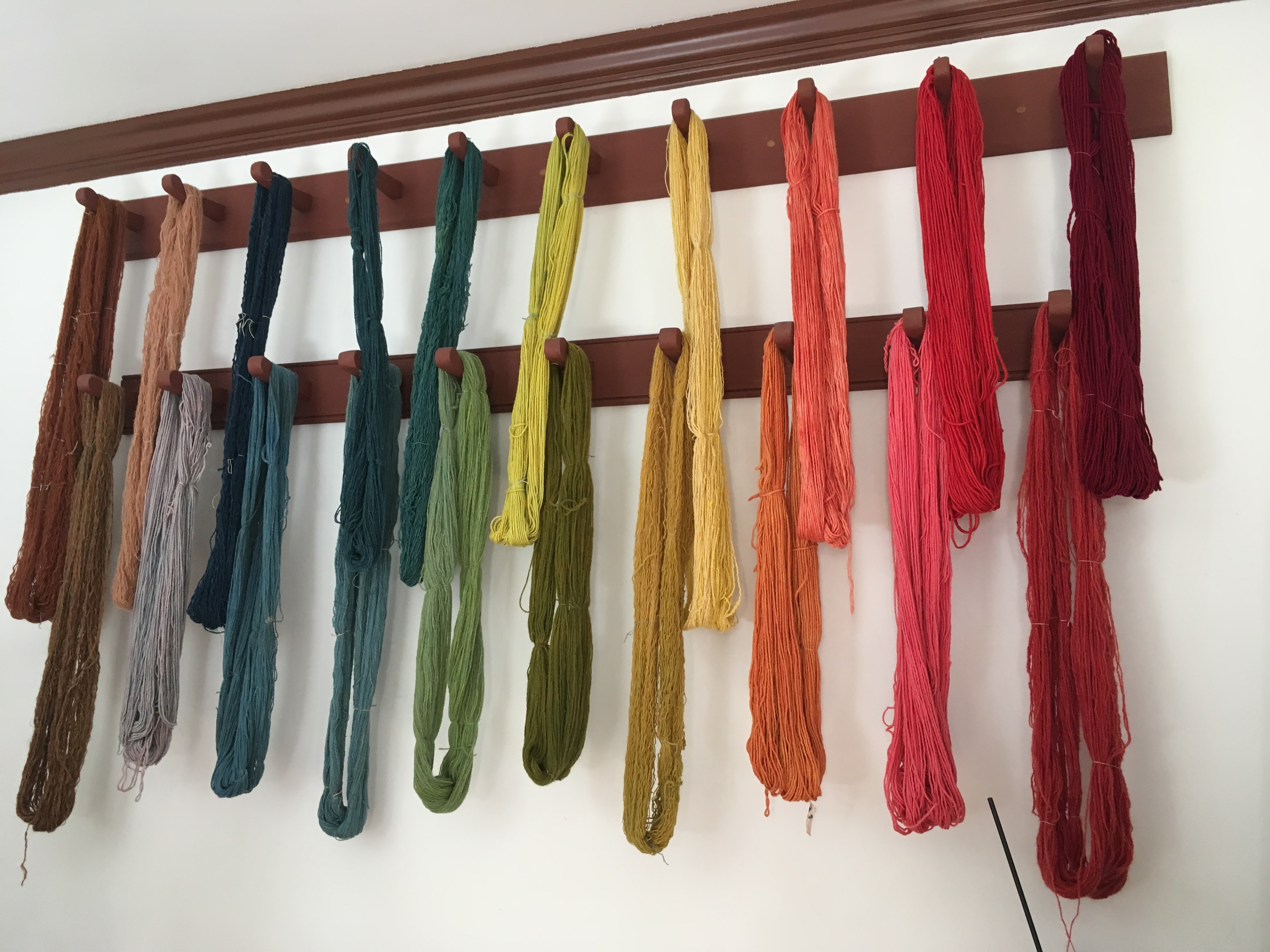Art and Mystery: the Weaver’s Shop at Colonial Williamsburg
During the eighteenth century, apprenticeship indentures frequently specified that masters were to teach their apprentices the “arts and mysteries” of their trade. Dyeing fibers retains those mysterious qualities. Despite mechanization and advanced chemistry, we still rely on dye lots to ensure that fiber colors will match perfectly. During my visit to the weaver’s shop at Colonial Williamsburg, I experienced the fun and frustration of dyeing fibers by hand.
Vats of dye over a fire
We tried out several different activities at the weaver shop, but the first was dyeing skeins of wool and cotton. The tradespeople had set up three large vats of dye (one with each of the primary colors) over open flames in a fire pit behind their shop. The blue dye was indigo, the red was cochineal, and the yellow was fustic. The tradespeople briefly demonstrated the process of dyeing with indigo, which is slightly trickier to work with than the other types of dye. Indigo-based dye only works after it oxidizes; the skein does not turn blue immediately, but only after prolonged exposure to air. Also, if oxidized pigment gets back in the dye pot it can ruin the batch. Because of this, we had to remove the skeins carefully, scraping the skeins against the side of the dye pot so that they wouldn’t drip. After this demonstration, the tradespeople let us try out dyeing for ourselves.
The weavers demonstrate how to use indigo dye
I could have happily spent all day experimenting with how to create different colors with the dye. In the limited amount of time we had, I dyed one skein of cotton blue, one skein of wool red, and tried my hand at turning one skein of each green, because it is my favorite color. I was surprised at how difficult it was to get the colors I wanted. I learned two important lessons about dyeing with a single type of pigment. First, it takes a very long time for a skein sitting in dye to take on the deep, rich colors that I was hoping for. Second, the eventual color depends on the material being dyed to some extent, as the colors showed up differently on wool and cotton.
A skein of wool that has been removed from the dye pot and is being washed
Mixing dyes to get the shade of green I wanted proved to be even more difficult. I had trouble figuring out how much time to keep the skeins in the blue and yellow dye pots in order to get just the right balance between the two. I can only imagine the amount of trial and error required to create the exact color I wanted on a single skein, never mind figuring out how to get the same result consistently. Dyers in the eighteenth century must have been extremely talented and knowledgeable to get the consistent colors they needed to attract and satisfy clients.
After finishing up with dyeing we moved inside to learn about patterns. The most basic weaving pattern is just a simple under-over plain weave, but weavers can create very intricate patterns depending on how they set up the loom and the order in which they push the pedals that move the heddles of the loom in the correct sequences. The tradespeople taught us how to draft different patterns using graph paper. While the meaning of the charts befuddled me at first (I was chastised for peeking at my classmates’ papers in order to figure out what I was supposed to be doing), I soon caught on to how to draft a pattern—at least at the most basic level.
Next, we had the opportunity to actually try weaving. The process of weaving is as simple as it looks, although I learned it requires finesse to do quickly and gracefully. The weaver steps on the pedals to create a pathway (called a shed) for the shuttle, sends the shuttle through that shed, and then uses the beater bar to slam the weft fibers tightly into the warp to ensure a close weave. Sounds simple, right? Well, the first time I sent the shuttle through, it went flying out of the shed and ended up on the floor. The next try, I tried to adjust for having been too forceful the first time; I also was using my non-dominant hand causing the shuttle get stuck about halfway through the shed. I had to carefully nudge it the rest of the way and avoid snapping any of the warp threads. The third time, after again having the shuttle clatter to the floor, the apprentices showed me how to use my other hand to catch the shuttle at the selvedge. Eventually, I got to the point where I was able to throw the shuttle through with exactly the right amount force with each hand.
Using the beater bar to create a tight weave
The final experience we had at the weaver shop was combing and carding wool to prepare it for spinning. I opted to try carding, which involves putting tufts of wool between two hand cards and gently brushing them together. The cards look a lot like the brush that my parents have for their dog, so I expected carding to be similar to the arduous process of trying to detangle the hair of a poodle. Instead, I found carding to be calming and meditative and I really enjoyed the tactile sensation of pulling wool between the cards.
I think I would have enjoyed being a weaver. The intellectual challenge of creating and mapping out complex patterns appealed to me and once I figured out how to throw the shuttle I felt quite adept weaving. On the other hand, when I thought about how fast I would have to weave to be able to feed myself, I realized that would probably make weaving a lot less fun and the monotonous, repetitive actions might eventually get to me.
A rainbow of skeins at the weavers’ shop
The weaver shop was my very last stop at the end of three exhausting days, but it was a delightful and thrilling way to finish off our trip. Having spent much of the day with the milliner and the tailor, who discussed the qualities and uses of different textiles, it was interesting to take several steps back and see how raw cotton or wool eventually becomes the colorful, textured pieces of fabric for sale in the milliner and tailor shops. I enjoyed my time with the weavers immensely and I would have loved to spend more time with any of the activities we tried.
.
By Aliza Alperin-Sheriff, MA Candidate, University of Delaware Department of History
.
For many years, the Department of Historic Trades at Colonial Williamsburg has generously hosted Winterthur students as part of a course in pre-industrial craftsmanship. Over the course of several days, we students work closely with the tradespeople, trying our hands at a wide range of eighteenth century occupations that bring our studies, quite literally, to life. Every year, we leave with a deeper understanding of the material world. This post is part of a series that chronicles our visit in March, 2017.






Wow-you are an amazing writer!
Dear Ms. Alperin-Sheriff, I ‘d like permission to use your photograph of the yarn in the weaver’s shop on an interpretive sign by our Dyer’s Garden at Historic Hanna’s Town in Greensburg, PA. My name is Joanna Moyar, and I am the collection’s manager for the Westmoreland Historical Society. Thank you.
Dear Ms. Alperin-Sheriff, I ‘d like permission to use your photograph of the yarn in the weaver’s shop on an interpretive sign by our Dyer’s Garden at Historic Hanna’s Town in Greensburg, PA. I am the collection’s manager for the Westmoreland Historical Society. Thank you.